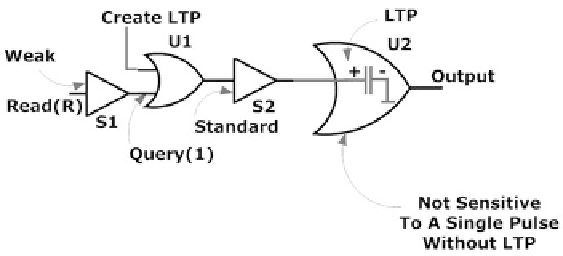Information Technology Reference
In-Depth Information
Fig. 4.1
LTP memory circuit model
is accessible to be queried, regular synapse S2 is modeled as a transconductance
amplifier that transmits one packet of charge when one voltage pulse is applied to its
input. The neuron responds to a single pulse such as forwarded by Query(1) only if
LTP has been created beforehand.
Memorization in this model means creating LTP, which means creating trapped
static charge (and storing energy). This concept is vaguely similar to that of
dynamic random access memory in home computers, in which a bit of data is
stored in the form of charge in a small capacitor. The difference is, dynamic
memory requires periodic refreshing every few milliseconds, whereas LTP is
assumed to last a very long time without refreshing.
Open questions about LTP are as follows.
1. What makes a receptor susceptible to LTP? It seems that these particular
synapses are perhaps special, since it is doubtful that a brain would work in
practice if each and every synapse eventually acquired LTP. An intractable
situation would be that many attempted queries to an element that is supposed
to hold a false, would eventually convert it into a true, if LTP is merely a matter
of applying many pulses. To create LTP, there has to be a special signal or code
that creates it, perhaps high amplitude pulses as used in the laboratory when
studying LTP.
2. Is the time to instill LTP too long? It seems like it would take excessive time to
create LTP using the kinds of neural signals that are readily available in a live
brain. This is said in view of the observation that major human memories can be
formed instantly. For example, emotional experiences often result in instant
memorization of times, places, and events, such as destructive enemy attacks,
the murder of well-known personalities, and so on. Beyond such unusual
circumstances, a lucky few have the gift of photographic memory, implying
instant verbatim memorization of massive amounts (books full) of information.
Fact is, long-term memorization often occurs instantly.
3. Can LTP actually last for decades without refreshing? Trapped charge in a
biological (or any other) environment tends to dissipate over time, partly due
to thermal activity, partly due to external radiation such as X-ray or cosmic,

Search WWH ::

Custom Search